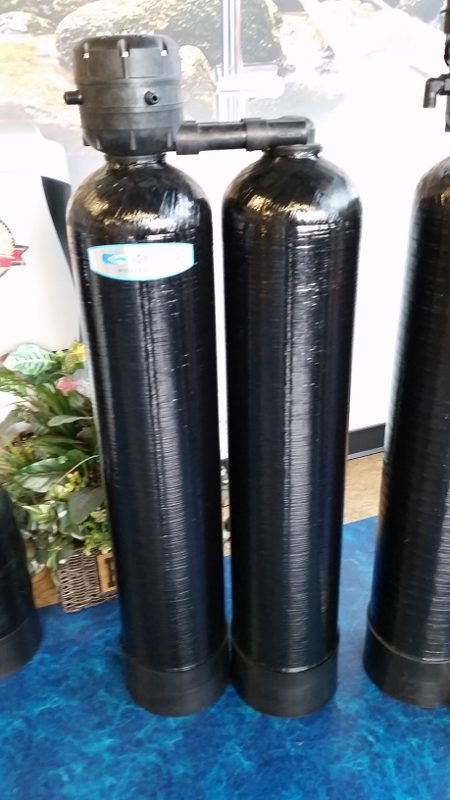Many residential households use water softeners to remove hardness from water. Water softening can have benefits including extending the life of appliances, preventing scale on fixtures, reducing energy use in water heaters and decreasing the amount of cleaning products needed. However, there are some negative environmental impacts such as increased water use, and chloride from the salt discharged into surface waters where it is harmful to aquatic plants and animals. General features of water treatment options are described below for comparison but will vary by manufacturer, unit and application.
Demand-initiated regeneration
Many older softener regenerations are time clock initiated, using electronic timers or clocks to recharge the resin at a preset time and day. This wastes salt and water because they regenerate whether or not regeneration is necessary. Most new softeners use a more sophisticated method called demand-initiated regeneration where regeneration is based on the measured amount of water used.
- Cost: $-$$
- Salt use: 26% to 60% less salt than time clock softeners
- Water treatment: Provides softened water
- Maintenance: Clean tank every five to 10 years and check salt levels monthly
- Water use: 25% to 40% less water than time clock softeners.
Twin tanks water softeners

Multitank systems will improve salt and water use efficiency. They allow for continuous soft water supply since no reserve capacity is needed in a dual-tank system, saving salt and water.
- Cost: $ — about 30% more than single tank softener
- Salt use: Up to 30% less salt than single tank softener
- Water treatment: Provides continuous soft water
- Maintenance: Clean brine tank every five to 10 years and check salt levels monthly
- Water use: 15% less water than single tank softener.
Hardness sensors
Some of the most efficient softeners are equipped with sensors that measure the hardness and initiate regeneration and/or adjust settings for optimal performance. Softeners with hardness sensors are best suited for areas where hardness fluctuates (check with city staff).
- Cost: $$-$$$ for softener with hardness sensor
- Salt use: Uses less salt
- Water treatment: Provides softened water
- Maintenance: Check softener manual
- Water use: May use less water.
Countercurrent regeneration
Downflow or cocurrent regeneration is the more common type of regeneration. Cocurrent softeners require less maintenance where water contains iron or manganese. Upflow or countercurrent regeneration uses brine more efficiently; the brine flows in the opposite direction of the service flow through the resin that is least depleted to the resin that is most depleted. Less salt is needed for this process than cocurrent regeneration.
- Cost: $-$$
- Salt use: Up to 40% to 50% less salt than cocurrent softeners
- Water treatment: Provides softened water
- Maintenance: Check salt levels monthly and refill; professional check every two to five years
- Water use: Up to 30% less water than cocurrent softeners.
Water softener replacement
Water softeners become less efficient as they age. Replacing old household water softeners with newer models can improve salt efficiency. Over time and use, valves weaken, resin beads deteriorate and softeners fail. Newer water softeners are designed to be more efficient.
- Cost: $-$$ for new softener
- Salt use: Up to about 50% less salt with new softener
- Water treatment: Provides softened water
- Maintenance: Check salt levels monthly and refill; professional check every two to five years and when family size changes
- Water use: Variable.
Exchange program

In a water softener exchange service or program, a company delivers a recharged resin tank to the customer’s home. When the tank needs to be regenerated, it is removed by the service company and taken to a central facility for regeneration. Tanks are exchanged on a regular schedule based on estimated water use and water hardness.
- Cost: $-$$
- Salt use: Will not reduce home salt use (salt is used to regenerate at central facility)
- Water treatment: Provides softened water
- Maintenance: No maintenance for homeowner, higher cost for tank delivery/exchange
- Water use: Will not reduce water use (water will be used at the central facility for regeneration).
Public health
Whether your customers are connected to a public water system or are on a private well, their health and the health of others is dependent on their water and plumbing. Serious disease outbreaks occur every year in the U.S. from plumbing mistakes or cross-contamination of plumbing systems. Licensed installers play an important role in safeguarding homeowners' plumbing.
Key to Costs: $ = less than $1,500
$$ = $1,500 to $2,500
$$$ = $2,500 to $5,000
$$$$ = greater than $5,000
About the author: Sara Heger, Ph.D., is an engineer, researcher and instructor in the Onsite Sewage Treatment Program in the Water Resources Center at the University of Minnesota. She presents at many local and national training events regarding the design, installation, and management of septic systems and related research. Heger is education chair of the Minnesota Onsite Wastewater Association and the National Onsite Wastewater Recycling Association, and she serves on the NSF International Committee on Wastewater Treatment Systems. Ask Heger questions about septic system maintenance and operation by sending an email to kim.peterson@colepublishing.com.
This article is a follow-up to Reducing Chloride From Home Water Softeners.





